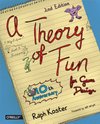
Theory of Fun for Game Design

Thinking is, in fact, mostly memory, pattern-matching against past experiences.
Raph Koster • Theory of Fun for Game Design
feelings is at that moment of triumph when we learn something or master a task.
Raph Koster • Theory of Fun for Game Design
Games that fail to exercise the brain become boring.
Raph Koster • Theory of Fun for Game Design
Either way, fun is defined as “a source of enjoyment.” This can happen via physical stimuli, aesthetic appreciation, or direct chemical manipulation.
Raph Koster • Theory of Fun for Game Design
This is why tic-tac-toe ends up falling down — it’s exercise, but so limited we don’t need to spend much time on it.
Raph Koster • Theory of Fun for Game Design
Fun is just another word for learning.* Games teach you how aspects of reality work, how to understand yourself, how to understand the actions of others, and how to imagine.
Raph Koster • Theory of Fun for Game Design
“gamification” which attempts to use the trappings of games (reward structures, points, etc.) to make people engage more with product offerings. Does it miss the point of games? It is often layered on top of systems that lack the rich interpretability of a good game. A reward structure alone does not a game make.
Raph Koster • Theory of Fun for Game Design
The world is full of systems that we can choose to approach as games, and by approaching them that way, we make them into games. Games are puzzles to solve, just like everything else we encounter in life. They are on the same order as learning to drive a car, play the mandolin,
Raph Koster • Theory of Fun for Game Design
I don’t need a degree in automotive engineering to drive my car. I don’t even need to understand torque, wheels and how the brakes work. I don’t need to remember the ins and outs of the rules of grammar to speak grammatically in everyday conversation. I don’t need to know whether tic-tac-toe is NP-hard or NP-complete* to know that it’s a dumb game.